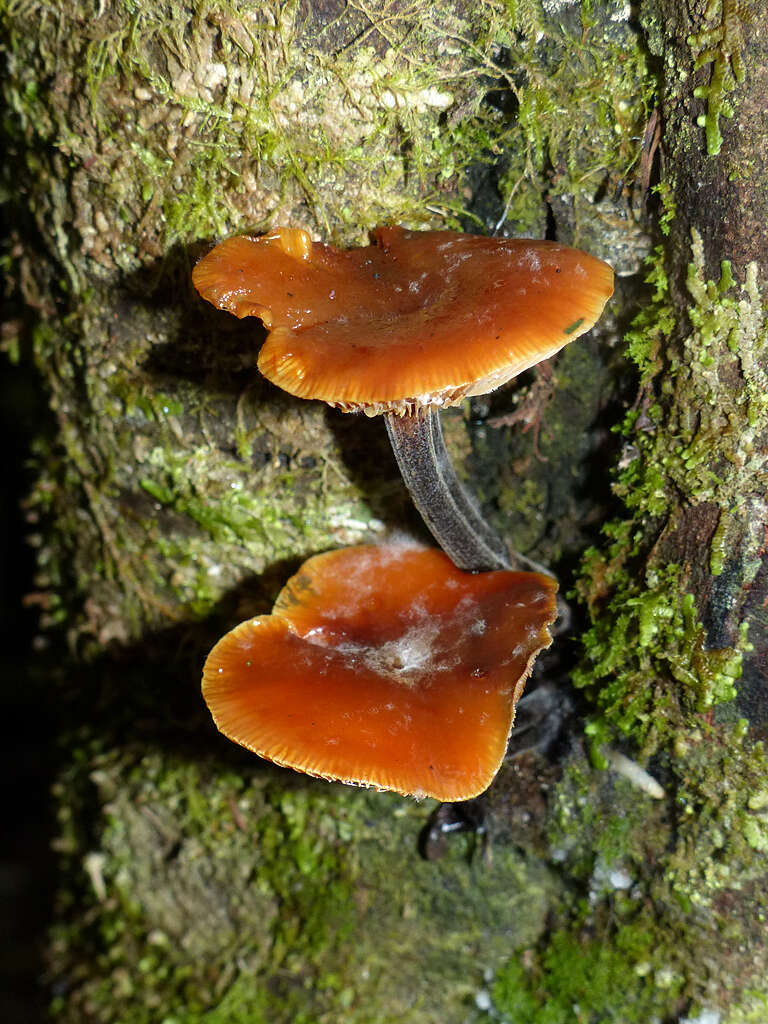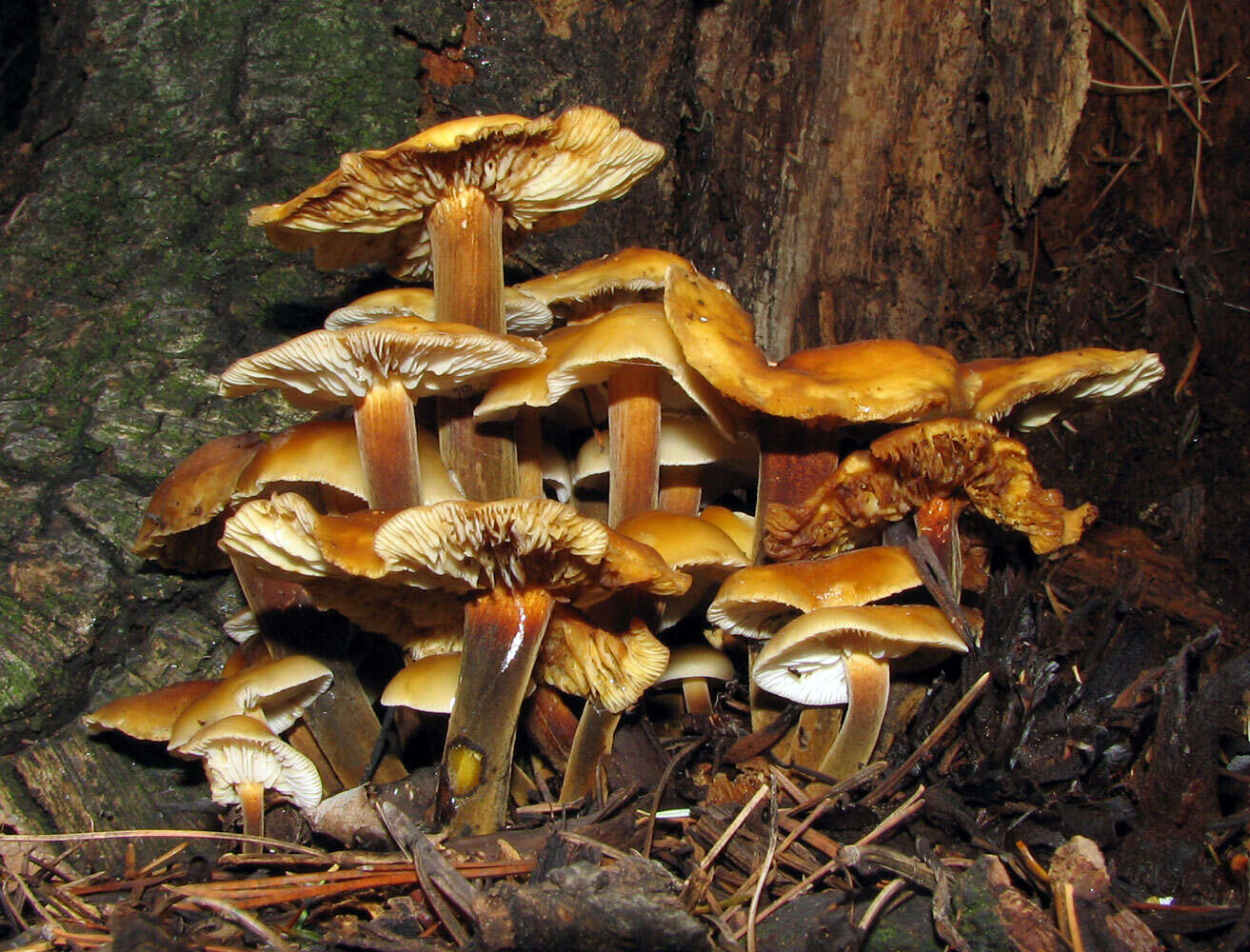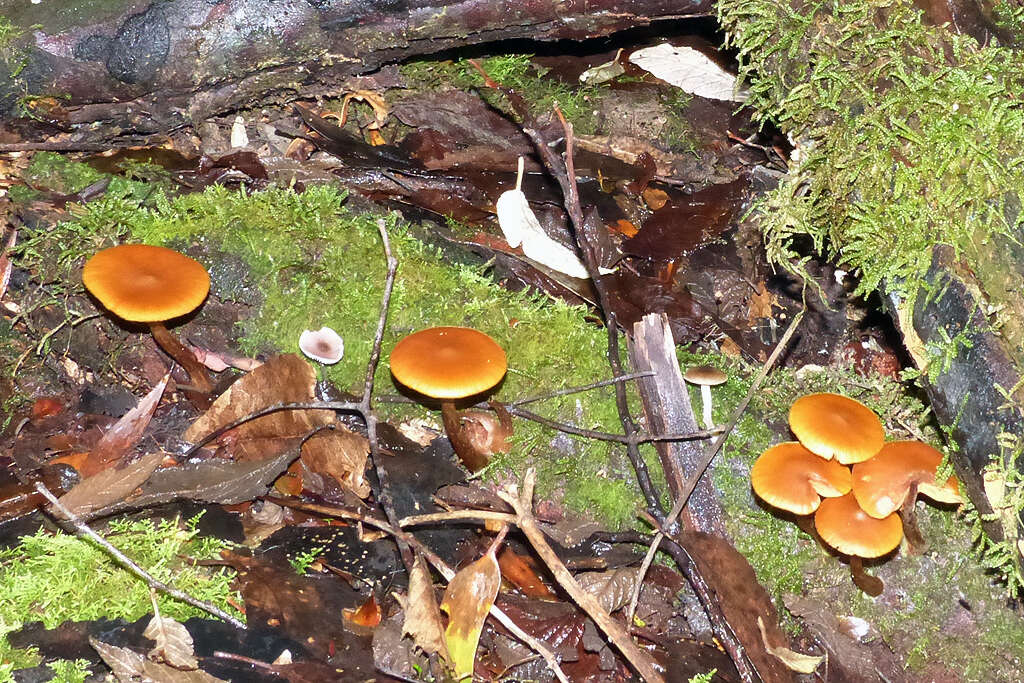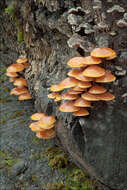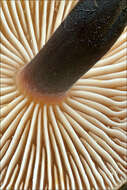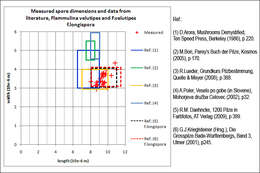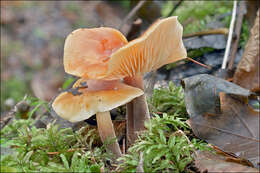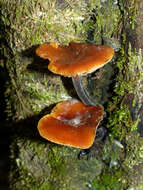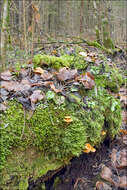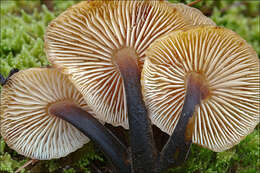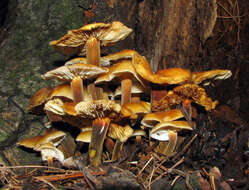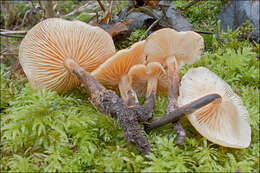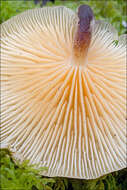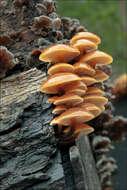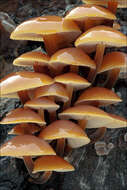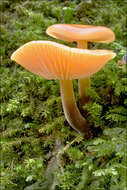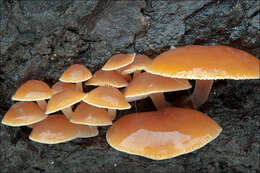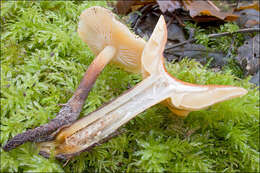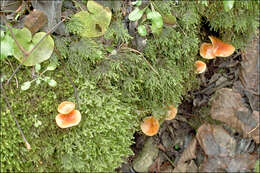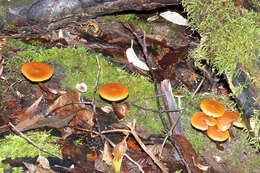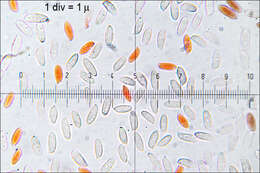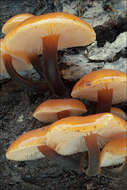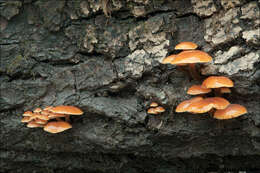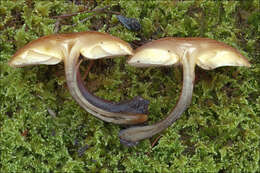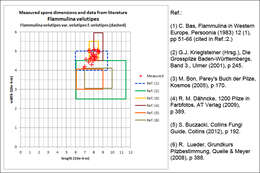-
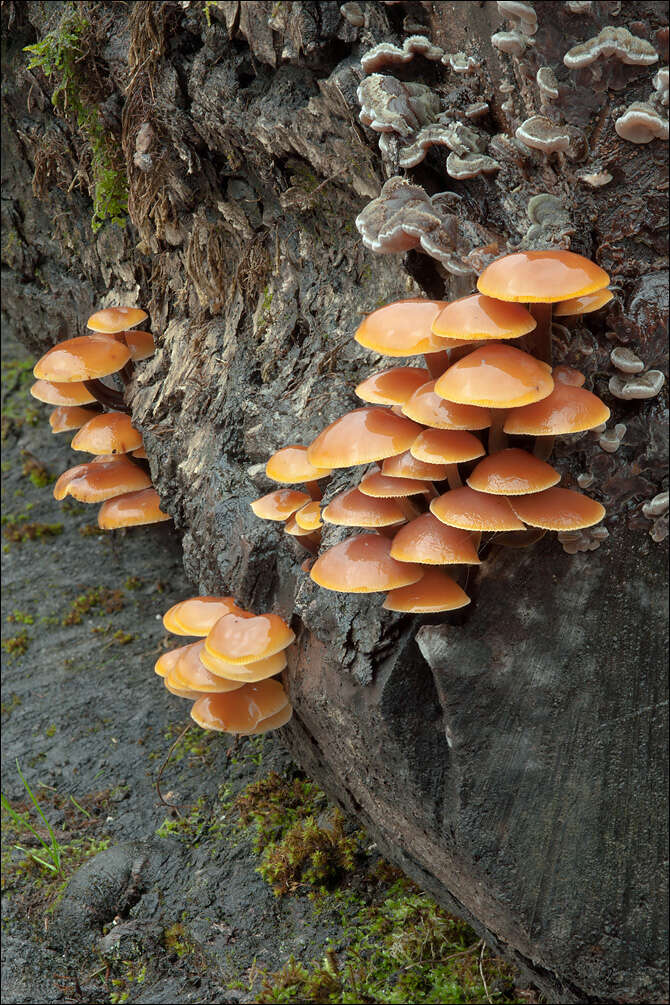
Flammulina velutipes (Curtis) SingerVelvet Shank, DE: Gemeiner Samtfussrbling, Gewonlicher SamtfssrublingSlo.: zimska panjevkaDat.: Nov. 28. 2014Lat.: 46.36066 Long.: 13.70907Code: Bot_851/2014_DSC4924Habitat: at the bottom of alpine valley, sawmill depot, next to the main road, flat terrain, full sun, humid place next to a river, exposed to direct rain, average precipitations ~ 3.000 mm/year, average temperature 7 - 9 deg C, elevation 550 m (1.800 feet), alpine phytogeographical region.Substratum: a big log of Juglans regia lying on ground in a pile of timber in a sawmill depot.Place: Lower Trenta valley, between villages Soa and Trenta, sawmill Otokar, Trenta 4, East Julian Alps, Posoje, Slovenia EC Comments: Flammulina velutipes is a striking fungus in several senses in spite of the fact that it is a widespread, common and easy to recognize. First, it is very beautiful mushroom displaying a vibrant contrast between its like fire orange, shiny and half translucent hut and deep black velvety stipe. Its rich colors exemplify an eye-catching contrast to often dull gray-brown mood of late autumn and winter nature in my country or to snow covered habitats. Its pilei withstand very low temperatures. Even completely frozen they recover and grow and sporulate after temperature again rises above freezing point. One can find them from October to March being most frequent in January (Ref.:2.). Another interesting thing is that they need short wavelength light (blue 470 nm and above) to develop pilei and to sporulate (Ref.:2.). I haven't found an explanation why they need it. Generally fungi do not need light since they have no chlorophyll to synthesize their own food.Flammulina velutipes grows as a saprobiont on wood of wide range of broadleaf trees, vast majority of them on Salix sp. and Fagus sylvatica. Fungi I found grew on Juglans regia, which is very seldom recorded. Only four of about thousand observations analyzed in Ref.:2. state Juglans regia as substratum. Taxonomy of this species is complex. Several taxa on f. and var. levels have been described. But, authors do not agree on them and Index Fungorum does not recognize them as valid names. The situation is well illustrated by the fact that there exist about 40 synonyms out of six genera. Also large differences in spore dimensions one can find in literature (see Fig. 2M) somehow confirm this.Pilei photographed grew in several clusters, more than 80 pilei altogether were present; pileus diameter 1.8 - 4.5 cm and height 1.2 - 1.8 cm, upper surface very slimy, stipe diameter 3 - 4 mm above and 3.5 - 7 mm at the base, hollow when mature, tough, fairly fibrous and often flattened or twisted; taste mild slightly on soap; smell very mild but distinct, on bleach?, SP abundant white, oac909.Spores dimensions: 7,0 [7,7 ; 8] 8,7 x 4,2 [4,6 ; 4,8] 5,2 microns; Q = 1,5 [1,6 ; 1,7] 1,8; N = 33; C = 95%; Me = 7,9 x 4,7 microns; Qe = 1,7. Olympus CH20, NEA 100x/1.25, magnification 1.000 x, oil, in water, Congo red. AmScope MA500 digital camera.Herbarium: Mycotheca and lichen herbarium (LJU-Li) of Slovenian Forestry Institute, Vena pot 2, Ljubljana, Index Herbariorum LJFRef.:(1) C. Bas, Flammulina in Western Europe, Persoonia (1983) 12 (1), pp 51-66 (cited in Ref.:2.) (2) G.J. Krieglsteiner (Hrsg.), Die Grosspilze Baden-Wrttembergs, Band 3., Ulmer (2001), p 245. (3) M. Bon, Parey's Buch der Pilze, Kosmos (2005), p 170.(4) R. M. Dhncke, 1200 Pilze in Farbfotos, AT Verlag (2009), p 389.(5) S. Buczacki, Collins Fungi Guide, Collins (2012), p 192. (6) R. Lueder, Grundkurs Pilzbestimmung, Quelle & Meyer (2008), p 388.(7)
trace.tennessee.edu/cgi/viewcontent.cgi?article=1006&...
-

Flammulina velutipes (Curtis) SingerVelvet Shank, DE: Gemeiner Samtfussrbling, Gewonlicher SamtfssrublingSlo.: zimska panjevkaDat.: Nov. 28. 2014Lat.: 46.36066 Long.: 13.70907Code: Bot_851/2014_DSC4924Habitat: at the bottom of alpine valley, sawmill depot, next to the main road, flat terrain, full sun, humid place next to a river, exposed to direct rain, average precipitations ~ 3.000 mm/year, average temperature 7 - 9 deg C, elevation 550 m (1.800 feet), alpine phytogeographical region.Substratum: a big log of Juglans regia lying on ground in a pile of timber in a sawmill depot.Place: Lower Trenta valley, between villages Soa and Trenta, sawmill Otokar, Trenta 4, East Julian Alps, Posoje, Slovenia EC Comments: Flammulina velutipes is a striking fungus in several senses in spite of the fact that it is a widespread, common and easy to recognize. First, it is very beautiful mushroom displaying a vibrant contrast between its like fire orange, shiny and half translucent hut and deep black velvety stipe. Its rich colors exemplify an eye-catching contrast to often dull gray-brown mood of late autumn and winter nature in my country or to snow covered habitats. Its pilei withstand very low temperatures. Even completely frozen they recover and grow and sporulate after temperature again rises above freezing point. One can find them from October to March being most frequent in January (Ref.:2.). Another interesting thing is that they need short wavelength light (blue 470 nm and above) to develop pilei and to sporulate (Ref.:2.). I haven't found an explanation why they need it. Generally fungi do not need light since they have no chlorophyll to synthesize their own food.Flammulina velutipes grows as a saprobiont on wood of wide range of broadleaf trees, vast majority of them on Salix sp. and Fagus sylvatica. Fungi I found grew on Juglans regia, which is very seldom recorded. Only four of about thousand observations analyzed in Ref.:2. state Juglans regia as substratum. Taxonomy of this species is complex. Several taxa on f. and var. levels have been described. But, authors do not agree on them and Index Fungorum does not recognize them as valid names. The situation is well illustrated by the fact that there exist about 40 synonyms out of six genera. Also large differences in spore dimensions one can find in literature (see Fig. 2M) somehow confirm this.Pilei photographed grew in several clusters, more than 80 pilei altogether were present; pileus diameter 1.8 - 4.5 cm and height 1.2 - 1.8 cm, upper surface very slimy, stipe diameter 3 - 4 mm above and 3.5 - 7 mm at the base, hollow when mature, tough, fairly fibrous and often flattened or twisted; taste mild slightly on soap; smell very mild but distinct, on bleach?, SP abundant white, oac909.Spores dimensions: 7,0 [7,7 ; 8] 8,7 x 4,2 [4,6 ; 4,8] 5,2 microns; Q = 1,5 [1,6 ; 1,7] 1,8; N = 33; C = 95%; Me = 7,9 x 4,7 microns; Qe = 1,7. Olympus CH20, NEA 100x/1.25, magnification 1.000 x, oil, in water, Congo red. AmScope MA500 digital camera.Herbarium: Mycotheca and lichen herbarium (LJU-Li) of Slovenian Forestry Institute, Vena pot 2, Ljubljana, Index Herbariorum LJFRef.:(1) C. Bas, Flammulina in Western Europe, Persoonia (1983) 12 (1), pp 51-66 (cited in Ref.:2.) (2) G.J. Krieglsteiner (Hrsg.), Die Grosspilze Baden-Wrttembergs, Band 3., Ulmer (2001), p 245. (3) M. Bon, Parey's Buch der Pilze, Kosmos (2005), p 170.(4) R. M. Dhncke, 1200 Pilze in Farbfotos, AT Verlag (2009), p 389.(5) S. Buczacki, Collins Fungi Guide, Collins (2012), p 192. (6) R. Lueder, Grundkurs Pilzbestimmung, Quelle & Meyer (2008), p 388.(7)
trace.tennessee.edu/cgi/viewcontent.cgi?article=1006&...
-
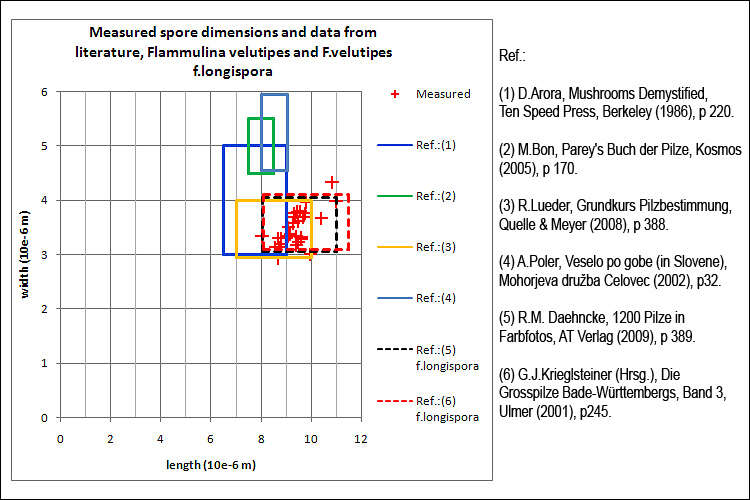
Flammulina velutipes, probably Flammulina velutipes f. longispora Bas, Persoonia 12(1): 62 (1983)Winter Mushroom, Velvet StemSlo.: zimska panjevkaDat.: Dec. 11. 2011Lat.: 46.33440 Long.: 13.59756Code: Bot_581/2011_IMG8137 Habitat: Mainly broadleaf forest next to river bed, locally flat terrain but in a short gorge, calcareous bedrock, very humid place with several springs, mostly in shade, no sun during winter months, partly protected from direct rain by tree canopies, average precipitations ~ 3.000 mm/year, average temperature 8-10 deg C, elevation 410 m (1.350 feet), alpine phytogeographical region.Substratum: fallen thick Salix sp. trunk covered by mosses, partly rotten.Place: East Bovec basin, left shore of river Soa downstream of Krovec farm house, East Julian Alps, Posoje, Slovenia EC Comments: Spore print as well as habitat fit well to Flammulina velutipes f. longispora Bas, Persoonia 12(1): 62 (1983). This form is not (yet?) accepted by Index Fungorum however it is discribed in Ref (5). and Ref.(6). from where spore dimensions have been taken for this form. Growing in small groups and solitary, several fruitbodies; pileus diameter up to 6 cm (2.3 inch), sticky cap; SP white. Spore dimensions: 9.3 (SD = 0.6) x 3.5 (SD = 0.3) micr., Q = 2.7 (SD = 0.18), n = 30. Motic B2-211A, magnification 1.000 x, oil, in water. Congo Red. Ref.:(1) D.Arora, Mushrooms Demystified, Ten Speed Press, Berkeley (1986), p 220. (2) M.Bon, Parey's Buch der Pilze, Kosmos (2005), p 170. (3) R.Lueder, Grundkurs Pilzbestimmung, Quelle & Meyer (2008), p 388. (4) A.Poler, Veselo po gobe (in Slovene), Mohorjeva druba Celovec (2002), p32. (5) R.M. Daehncke, 1200 Pilze in Farbfotos, AT Verlag (2009), p 389. (6) G.J.Krieglsteiner (Hrsg.), Die Grosspilze Bade-Wrttembergs, Band 3, Ulmer (2001), p245.
-
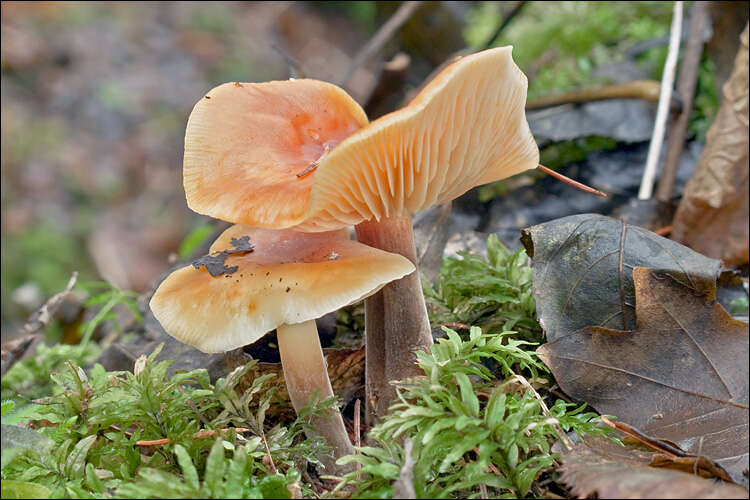
Flammulina velutipes, probably Flammulina velutipes f. longispora Bas, Persoonia 12(1): 62 (1983)Winter Mushroom, Velvet StemSlo.: zimska panjevkaDat.: Dec. 11. 2011Lat.: 46.33440 Long.: 13.59756Code: Bot_581/2011_IMG8137 Habitat: Mainly broadleaf forest next to river bed, locally flat terrain but in a short gorge, calcareous bedrock, very humid place with several springs, mostly in shade, no sun during winter months, partly protected from direct rain by tree canopies, average precipitations ~ 3.000 mm/year, average temperature 8-10 deg C, elevation 410 m (1.350 feet), alpine phytogeographical region.Substratum: fallen thick Salix sp. trunk covered by mosses, partly rotten.Place: East Bovec basin, left shore of river Soa downstream of Krovec farm house, East Julian Alps, Posoje, Slovenia EC Comments: Spore print as well as habitat fit well to Flammulina velutipes f. longispora Bas, Persoonia 12(1): 62 (1983). This form is not (yet?) accepted by Index Fungorum however it is discribed in Ref (5). and Ref.(6). from where spore dimensions have been taken for this form. Growing in small groups and solitary, several fruitbodies; pileus diameter up to 6 cm (2.3 inch), sticky cap; SP white. Spore dimensions: 9.3 (SD = 0.6) x 3.5 (SD = 0.3) micr., Q = 2.7 (SD = 0.18), n = 30.Ref.:(1) D.Arora, Mushrooms Demystified, Ten Speed Press, Berkeley (1986), p 220. (2) M.Bon, Parey's Buch der Pilze, Kosmos (2005), p 170. (3) R.Lueder, Grundkurs Pilzbestimmung, Quelle & Meyer (2008), p 388. (4) A.Poler, Veselo po gobe (in Slovene), Mohorjeva druba Celovec (2002), p32. (5) R.M. Daehncke, 1200 Pilze in Farbfotos, AT Verlag (2009), p 389. (6) G.J.Krieglsteiner (Hrsg.), Die Grosspilze Bade-Wrttembergs, Band 3, Ulmer (2001), p245.
-
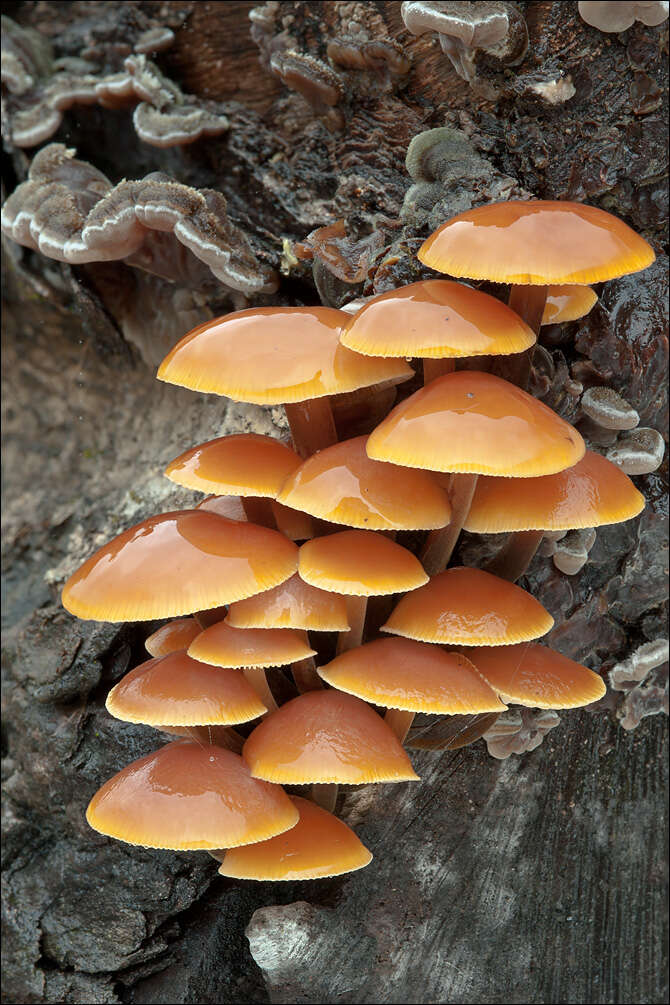
Flammulina velutipes (Curtis) SingerVelvet Shank, DE: Gemeiner Samtfussrbling, Gewonlicher SamtfssrublingSlo.: zimska panjevkaDat.: Nov. 28. 2014Lat.: 46.36066 Long.: 13.70907Code: Bot_851/2014_DSC4924Habitat: at the bottom of alpine valley, sawmill depot, next to the main road, flat terrain, full sun, humid place next to a river, exposed to direct rain, average precipitations ~ 3.000 mm/year, average temperature 7 - 9 deg C, elevation 550 m (1.800 feet), alpine phytogeographical region.Substratum: a big log of Juglans regia lying on ground in a pile of timber in a sawmill depot.Place: Lower Trenta valley, between villages Soa and Trenta, sawmill Otokar, Trenta 4, East Julian Alps, Posoje, Slovenia EC Comments: Flammulina velutipes is a striking fungus in several senses in spite of the fact that it is a widespread, common and easy to recognize. First, it is very beautiful mushroom displaying a vibrant contrast between its like fire orange, shiny and half translucent hut and deep black velvety stipe. Its rich colors exemplify an eye-catching contrast to often dull gray-brown mood of late autumn and winter nature in my country or to snow covered habitats. Its pilei withstand very low temperatures. Even completely frozen they recover and grow and sporulate after temperature again rises above freezing point. One can find them from October to March being most frequent in January (Ref.:2.). Another interesting thing is that they need short wavelength light (blue 470 nm and above) to develop pilei and to sporulate (Ref.:2.). I haven't found an explanation why they need it. Generally fungi do not need light since they have no chlorophyll to synthesize their own food.Flammulina velutipes grows as a saprobiont on wood of wide range of broadleaf trees, vast majority of them on Salix sp. and Fagus sylvatica. Fungi I found grew on Juglans regia, which is very seldom recorded. Only four of about thousand observations analyzed in Ref.:2. state Juglans regia as substratum. Taxonomy of this species is complex. Several taxa on f. and var. levels have been described. But, authors do not agree on them and Index Fungorum does not recognize them as valid names. The situation is well illustrated by the fact that there exist about 40 synonyms out of six genera. Also large differences in spore dimensions one can find in literature (see Fig. 2M) somehow confirm this.Pilei photographed grew in several clusters, more than 80 pilei altogether were present; pileus diameter 1.8 - 4.5 cm and height 1.2 - 1.8 cm, upper surface very slimy, stipe diameter 3 - 4 mm above and 3.5 - 7 mm at the base, hollow when mature, tough, fairly fibrous and often flattened or twisted; taste mild slightly on soap; smell very mild but distinct, on bleach?, SP abundant white, oac909.Spores dimensions: 7,0 [7,7 ; 8] 8,7 x 4,2 [4,6 ; 4,8] 5,2 microns; Q = 1,5 [1,6 ; 1,7] 1,8; N = 33; C = 95%; Me = 7,9 x 4,7 microns; Qe = 1,7. Olympus CH20, NEA 100x/1.25, magnification 1.000 x, oil, in water, Congo red. AmScope MA500 digital camera.Herbarium: Mycotheca and lichen herbarium (LJU-Li) of Slovenian Forestry Institute, Vena pot 2, Ljubljana, Index Herbariorum LJFRef.:(1) C. Bas, Flammulina in Western Europe, Persoonia (1983) 12 (1), pp 51-66 (cited in Ref.:2.) (2) G.J. Krieglsteiner (Hrsg.), Die Grosspilze Baden-Wrttembergs, Band 3., Ulmer (2001), p 245. (3) M. Bon, Parey's Buch der Pilze, Kosmos (2005), p 170.(4) R. M. Dhncke, 1200 Pilze in Farbfotos, AT Verlag (2009), p 389.(5) S. Buczacki, Collins Fungi Guide, Collins (2012), p 192. (6) R. Lueder, Grundkurs Pilzbestimmung, Quelle & Meyer (2008), p 388.(7)
trace.tennessee.edu/cgi/viewcontent.cgi?article=1006&...
-

Flammulina velutipes, probably Flammulina velutipes f. longispora Bas, Persoonia 12(1): 62 (1983)Winter Mushroom, Velvet StemSlo.: zimska panjevkaDat.: Dec. 11. 2011Lat.: 46.33440 Long.: 13.59756Code: Bot_581/2011_IMG8137 Habitat: Mainly broadleaf forest next to river bed, locally flat terrain but in a short gorge, calcareous bedrock, very humid place with several springs, mostly in shade, no sun during winter months, partly protected from direct rain by tree canopies, average precipitations ~ 3.000 mm/year, average temperature 8-10 deg C, elevation 410 m (1.350 feet), alpine phytogeographical region.Substratum: fallen thick Salix sp. trunk covered by mosses, partly rotten.Place: East Bovec basin, left shore of river Soa downstream of Krovec farm house, East Julian Alps, Posoje, Slovenia EC Comments: Young fruitbodies! Spore print as well as habitat fit well to Flammulina velutipes f. longispora Bas, Persoonia 12(1): 62 (1983). This form is not (yet?) accepted by Index Fungorum however it is discribed in Ref (5). and Ref.(6). from where spore dimensions have been taken for this form. Growing in small groups and solitary, several fruitbodies; pileus diameter up to 6 cm (2.3 inch), sticky cap; SP white. Spore dimensions: 9.3 (SD = 0.6) x 3.5 (SD = 0.3) micr., Q = 2.7 (SD = 0.18), n = 30.Ref.:(1) D.Arora, Mushrooms Demystified, Ten Speed Press, Berkeley (1986), p 220. (2) M.Bon, Parey's Buch der Pilze, Kosmos (2005), p 170. (3) R.Lueder, Grundkurs Pilzbestimmung, Quelle & Meyer (2008), p 388. (4) A.Poler, Veselo po gobe (in Slovene), Mohorjeva druba Celovec (2002), p32. (5) R.M. Daehncke, 1200 Pilze in Farbfotos, AT Verlag (2009), p 389. (6) G.J.Krieglsteiner (Hrsg.), Die Grosspilze Bade-Wrttembergs, Band 3, Ulmer (2001), p245.
-
-
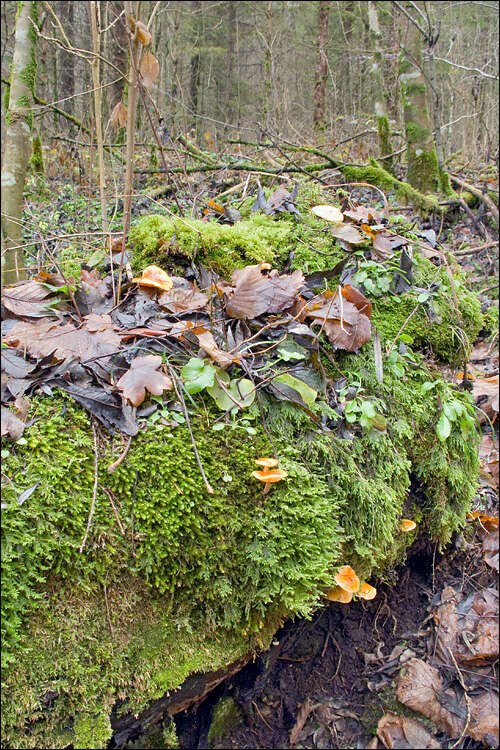
Flammulina velutipes, probably Flammulina velutipes f. longispora Bas, Persoonia 12(1): 62 (1983)Winter Mushroom, Velvet StemSlo.: zimska panjevkaDat.: Dec. 11. 2011Lat.: 46.33440 Long.: 13.59756Code: Bot_581/2011_IMG8137 Habitat: Mainly broadleaf forest next to river bed, locally flat terrain but in a short gorge, calcareous bedrock, very humid place with several springs, mostly in shade, no sun during winter months, partly protected from direct rain by tree canopies, average precipitations ~ 3.000 mm/year, average temperature 8-10 deg C, elevation 410 m (1.350 feet), alpine phytogeographical region.Substratum: fallen thick Salix sp. trunk covered by mosses, partly rotten.Place: East Bovec basin, left shore of river Soa downstream of Krovec farm house, East Julian Alps, Posoje, Slovenia EC Comments: Spore print as well as habitat fit well to Flammulina velutipes f. longispora Bas, Persoonia 12(1): 62 (1983). This form is not (yet?) accepted by Index Fungorum however it is discribed in Ref (5). and Ref.(6). from where spore dimensions have been taken for this form. Growing in small groups and solitary, several fruitbodies; pileus diameter up to 6 cm (2.3 inch), sticky cap; SP white. Spore dimensions: 9.3 (SD = 0.6) x 3.5 (SD = 0.3) micr., Q = 2.7 (SD = 0.18), n = 30.Ref.:(1) D.Arora, Mushrooms Demystified, Ten Speed Press, Berkeley (1986), p 220. (2) M.Bon, Parey's Buch der Pilze, Kosmos (2005), p 170. (3) R.Lueder, Grundkurs Pilzbestimmung, Quelle & Meyer (2008), p 388. (4) A.Poler, Veselo po gobe (in Slovene), Mohorjeva druba Celovec (2002), p32. (5) R.M. Daehncke, 1200 Pilze in Farbfotos, AT Verlag (2009), p 389. (6) G.J.Krieglsteiner (Hrsg.), Die Grosspilze Bade-Wrttembergs, Band 3, Ulmer (2001), p245.
-
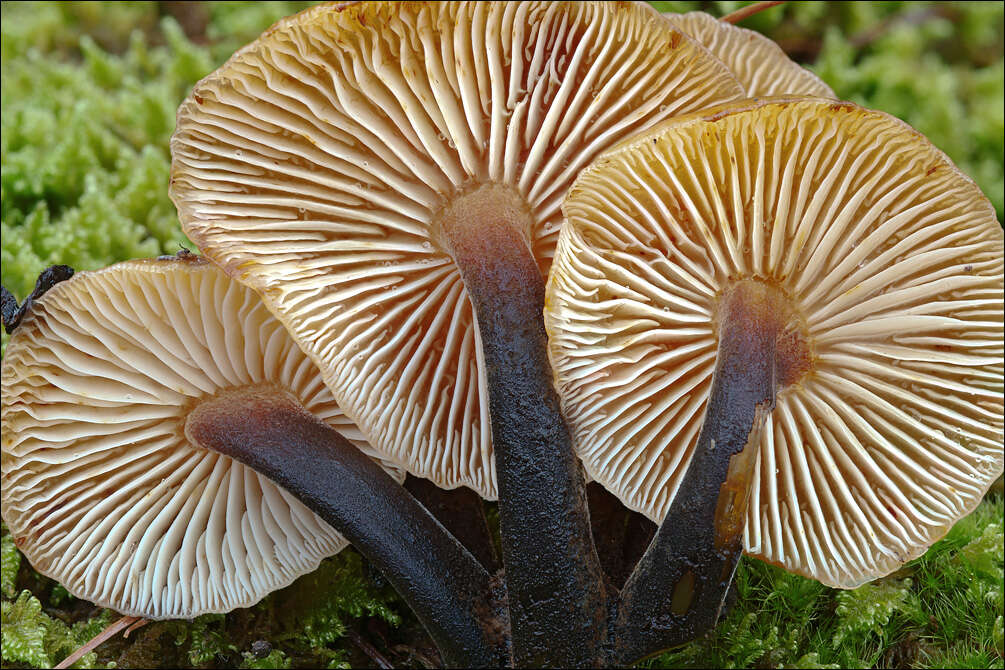
Flammulina velutipes (Curtis) SingerVelvet Shank, DE: Gemeiner Samtfussrbling, Gewonlicher SamtfssrublingSlo.: zimska panjevkaDat.: Nov. 28. 2014Lat.: 46.36066 Long.: 13.70907Code: Bot_851/2014_DSC4924Habitat: at the bottom of alpine valley, sawmill depot, next to the main road, flat terrain, full sun, humid place next to a river, exposed to direct rain, average precipitations ~ 3.000 mm/year, average temperature 7 - 9 deg C, elevation 550 m (1.800 feet), alpine phytogeographical region.Substratum: a big log of Juglans regia lying on ground in a pile of timber in a sawmill depot.Place: Lower Trenta valley, between villages Soa and Trenta, sawmill Otokar, Trenta 4, East Julian Alps, Posoje, Slovenia EC Comments: Flammulina velutipes is a striking fungus in several senses in spite of the fact that it is a widespread, common and easy to recognize. First, it is very beautiful mushroom displaying a vibrant contrast between its like fire orange, shiny and half translucent hut and deep black velvety stipe. Its rich colors exemplify an eye-catching contrast to often dull gray-brown mood of late autumn and winter nature in my country or to snow covered habitats. Its pilei withstand very low temperatures. Even completely frozen they recover and grow and sporulate after temperature again rises above freezing point. One can find them from October to March being most frequent in January (Ref.:2.). Another interesting thing is that they need short wavelength light (blue 470 nm and above) to develop pilei and to sporulate (Ref.:2.). I haven't found an explanation why they need it. Generally fungi do not need light since they have no chlorophyll to synthesize their own food.Flammulina velutipes grows as a saprobiont on wood of wide range of broadleaf trees, vast majority of them on Salix sp. and Fagus sylvatica. Fungi I found grew on Juglans regia, which is very seldom recorded. Only four of about thousand observations analyzed in Ref.:2. state Juglans regia as substratum. Taxonomy of this species is complex. Several taxa on f. and var. levels have been described. But, authors do not agree on them and Index Fungorum does not recognize them as valid names. The situation is well illustrated by the fact that there exist about 40 synonyms out of six genera. Also large differences in spore dimensions one can find in literature (see Fig. 2M) somehow confirm this.Pilei photographed grew in several clusters, more than 80 pilei altogether were present; pileus diameter 1.8 - 4.5 cm and height 1.2 - 1.8 cm, upper surface very slimy, stipe diameter 3 - 4 mm above and 3.5 - 7 mm at the base, hollow when mature, tough, fairly fibrous and often flattened or twisted; taste mild slightly on soap; smell very mild but distinct, on bleach?, SP abundant white, oac909.Spores dimensions: 7,0 [7,7 ; 8] 8,7 x 4,2 [4,6 ; 4,8] 5,2 microns; Q = 1,5 [1,6 ; 1,7] 1,8; N = 33; C = 95%; Me = 7,9 x 4,7 microns; Qe = 1,7. Olympus CH20, NEA 100x/1.25, magnification 1.000 x, oil, in water, Congo red. AmScope MA500 digital camera.Herbarium: Mycotheca and lichen herbarium (LJU-Li) of Slovenian Forestry Institute, Vena pot 2, Ljubljana, Index Herbariorum LJFRef.:(1) C. Bas, Flammulina in Western Europe, Persoonia (1983) 12 (1), pp 51-66 (cited in Ref.:2.) (2) G.J. Krieglsteiner (Hrsg.), Die Grosspilze Baden-Wrttembergs, Band 3., Ulmer (2001), p 245. (3) M. Bon, Parey's Buch der Pilze, Kosmos (2005), p 170.(4) R. M. Dhncke, 1200 Pilze in Farbfotos, AT Verlag (2009), p 389.(5) S. Buczacki, Collins Fungi Guide, Collins (2012), p 192. (6) R. Lueder, Grundkurs Pilzbestimmung, Quelle & Meyer (2008), p 388.(7)
trace.tennessee.edu/cgi/viewcontent.cgi?article=1006&...
-
Summerhaven, Arizona, United States
-
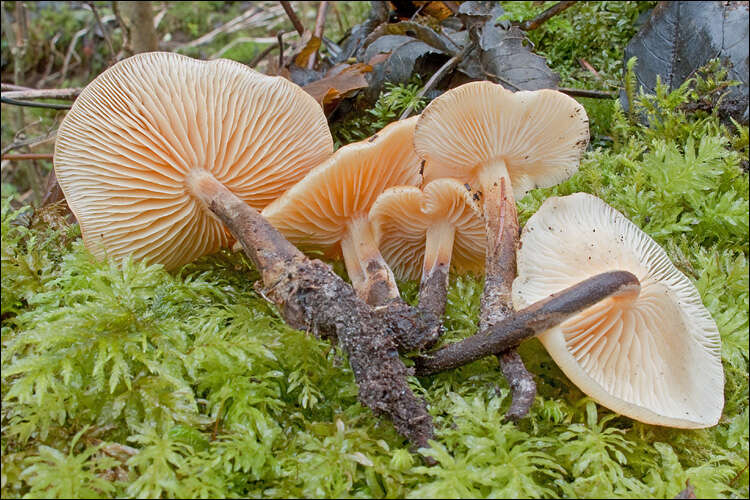
Flammulina velutipes, probably Flammulina velutipes f. longispora Bas, Persoonia 12(1): 62 (1983)Winter Mushroom, Velvet StemSlo.: zimska panjevkaDat.: Dec. 11. 2011Lat.: 46.33440 Long.: 13.59756Code: Bot_581/2011_IMG8137 Habitat: Mainly broadleaf forest next to river bed, locally flat terrain but in a short gorge, calcareous bedrock, very humid place with several springs, mostly in shade, no sun during winter months, partly protected from direct rain by tree canopies, average precipitations ~ 3.000 mm/year, average temperature 8-10 deg C, elevation 410 m (1.350 feet), alpine phytogeographical region.Substratum: fallen thick Salix sp. trunk covered by mosses, partly rotten.Place: East Bovec basin, left shore of river Soa downstream of Krovec farm house, East Julian Alps, Posoje, Slovenia EC Comments: Spore print as well as habitat fit well to Flammulina velutipes f. longispora Bas, Persoonia 12(1): 62 (1983). This form is not (yet?) accepted by Index Fungorum however it is discribed in Ref (5). and Ref.(6). from where spore dimensions have been taken for this form. Growing in small groups and solitary, several fruitbodies; pileus diameter up to 6 cm (2.3 inch), sticky cap; SP white. Spore dimensions: 9.3 (SD = 0.6) x 3.5 (SD = 0.3) micr., Q = 2.7 (SD = 0.18), n = 30.Ref.:(1) D.Arora, Mushrooms Demystified, Ten Speed Press, Berkeley (1986), p 220. (2) M.Bon, Parey's Buch der Pilze, Kosmos (2005), p 170. (3) R.Lueder, Grundkurs Pilzbestimmung, Quelle & Meyer (2008), p 388. (4) A.Poler, Veselo po gobe (in Slovene), Mohorjeva druba Celovec (2002), p32. (5) R.M. Daehncke, 1200 Pilze in Farbfotos, AT Verlag (2009), p 389. (6) G.J.Krieglsteiner (Hrsg.), Die Grosspilze Bade-Wrttembergs, Band 3, Ulmer (2001), p245.
-
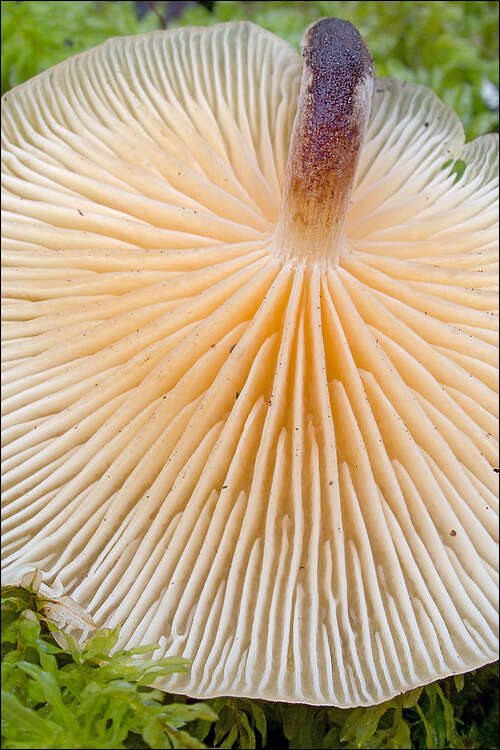
Flammulina velutipes, probably Flammulina velutipes f. longispora Bas, Persoonia 12(1): 62 (1983)Winter Mushroom, Velvet StemSlo.: zimska panjevkaDat.: Dec. 11. 2011Lat.: 46.33440 Long.: 13.59756Code: Bot_581/2011_IMG8137 Habitat: Mainly broadleaf forest next to river bed, locally flat terrain but in a short gorge, calcareous bedrock, very humid place with several springs, mostly in shade, no sun during winter months, partly protected from direct rain by tree canopies, average precipitations ~ 3.000 mm/year, average temperature 8-10 deg C, elevation 410 m (1.350 feet), alpine phytogeographical region.Substratum: fallen thick Salix sp. trunk covered by mosses, partly rotten.Place: East Bovec basin, left shore of river Soa downstream of Krovec farm house, East Julian Alps, Posoje, Slovenia EC Comments: Spore print as well as habitat fit well to Flammulina velutipes f. longispora Bas, Persoonia 12(1): 62 (1983). This form is not (yet?) accepted by Index Fungorum however it is discribed in Ref (5). and Ref.(6). from where spore dimensions have been taken for this form. Growing in small groups and solitary, several fruitbodies; pileus diameter up to 6 cm (2.3 inch), sticky cap; SP white. Spore dimensions: 9.3 (SD = 0.6) x 3.5 (SD = 0.3) micr., Q = 2.7 (SD = 0.18), n = 30.Ref.:(1) D.Arora, Mushrooms Demystified, Ten Speed Press, Berkeley (1986), p 220. (2) M.Bon, Parey's Buch der Pilze, Kosmos (2005), p 170. (3) R.Lueder, Grundkurs Pilzbestimmung, Quelle & Meyer (2008), p 388. (4) A.Poler, Veselo po gobe (in Slovene), Mohorjeva druba Celovec (2002), p32. (5) R.M. Daehncke, 1200 Pilze in Farbfotos, AT Verlag (2009), p 389. (6) G.J.Krieglsteiner (Hrsg.), Die Grosspilze Bade-Wrttembergs, Band 3, Ulmer (2001), p245.
-

Flammulina velutipes (Curtis) SingerVelvet Shank, DE: Gemeiner Samtfussrbling, Gewonlicher SamtfssrublingSlo.: zimska panjevkaDat.: Nov. 28. 2014Lat.: 46.36066 Long.: 13.70907Code: Bot_851/2014_DSC4924Habitat: at the bottom of alpine valley, sawmill depot, next to the main road, flat terrain, full sun, humid place next to a river, exposed to direct rain, average precipitations ~ 3.000 mm/year, average temperature 7 - 9 deg C, elevation 550 m (1.800 feet), alpine phytogeographical region.Substratum: a big log of Juglans regia lying on ground in a pile of timber in a sawmill depot.Place: Lower Trenta valley, between villages Soa and Trenta, sawmill Otokar, Trenta 4, East Julian Alps, Posoje, Slovenia EC Comments: Flammulina velutipes is a striking fungus in several senses in spite of the fact that it is a widespread, common and easy to recognize. First, it is very beautiful mushroom displaying a vibrant contrast between its like fire orange, shiny and half translucent hut and deep black velvety stipe. Its rich colors exemplify an eye-catching contrast to often dull gray-brown mood of late autumn and winter nature in my country or to snow covered habitats. Its pilei withstand very low temperatures. Even completely frozen they recover and grow and sporulate after temperature again rises above freezing point. One can find them from October to March being most frequent in January (Ref.:2.). Another interesting thing is that they need short wavelength light (blue 470 nm and above) to develop pilei and to sporulate (Ref.:2.). I haven't found an explanation why they need it. Generally fungi do not need light since they have no chlorophyll to synthesize their own food.Flammulina velutipes grows as a saprobiont on wood of wide range of broadleaf trees, vast majority of them on Salix sp. and Fagus sylvatica. Fungi I found grew on Juglans regia, which is very seldom recorded. Only four of about thousand observations analyzed in Ref.:2. state Juglans regia as substratum. Taxonomy of this species is complex. Several taxa on f. and var. levels have been described. But, authors do not agree on them and Index Fungorum does not recognize them as valid names. The situation is well illustrated by the fact that there exist about 40 synonyms out of six genera. Also large differences in spore dimensions one can find in literature (see Fig. 2M) somehow confirm this.Pilei photographed grew in several clusters, more than 80 pilei altogether were present; pileus diameter 1.8 - 4.5 cm and height 1.2 - 1.8 cm, upper surface very slimy, stipe diameter 3 - 4 mm above and 3.5 - 7 mm at the base, hollow when mature, tough, fairly fibrous and often flattened or twisted; taste mild slightly on soap; smell very mild but distinct, on bleach?, SP abundant white, oac909.Spores dimensions: 7,0 [7,7 ; 8] 8,7 x 4,2 [4,6 ; 4,8] 5,2 microns; Q = 1,5 [1,6 ; 1,7] 1,8; N = 33; C = 95%; Me = 7,9 x 4,7 microns; Qe = 1,7. Olympus CH20, NEA 100x/1.25, magnification 1.000 x, oil, in water, Congo red. AmScope MA500 digital camera.Herbarium: Mycotheca and lichen herbarium (LJU-Li) of Slovenian Forestry Institute, Vena pot 2, Ljubljana, Index Herbariorum LJFRef.:(1) C. Bas, Flammulina in Western Europe, Persoonia (1983) 12 (1), pp 51-66 (cited in Ref.:2.) (2) G.J. Krieglsteiner (Hrsg.), Die Grosspilze Baden-Wrttembergs, Band 3., Ulmer (2001), p 245. (3) M. Bon, Parey's Buch der Pilze, Kosmos (2005), p 170.(4) R. M. Dhncke, 1200 Pilze in Farbfotos, AT Verlag (2009), p 389.(5) S. Buczacki, Collins Fungi Guide, Collins (2012), p 192. (6) R. Lueder, Grundkurs Pilzbestimmung, Quelle & Meyer (2008), p 388.(7)
trace.tennessee.edu/cgi/viewcontent.cgi?article=1006&...
-
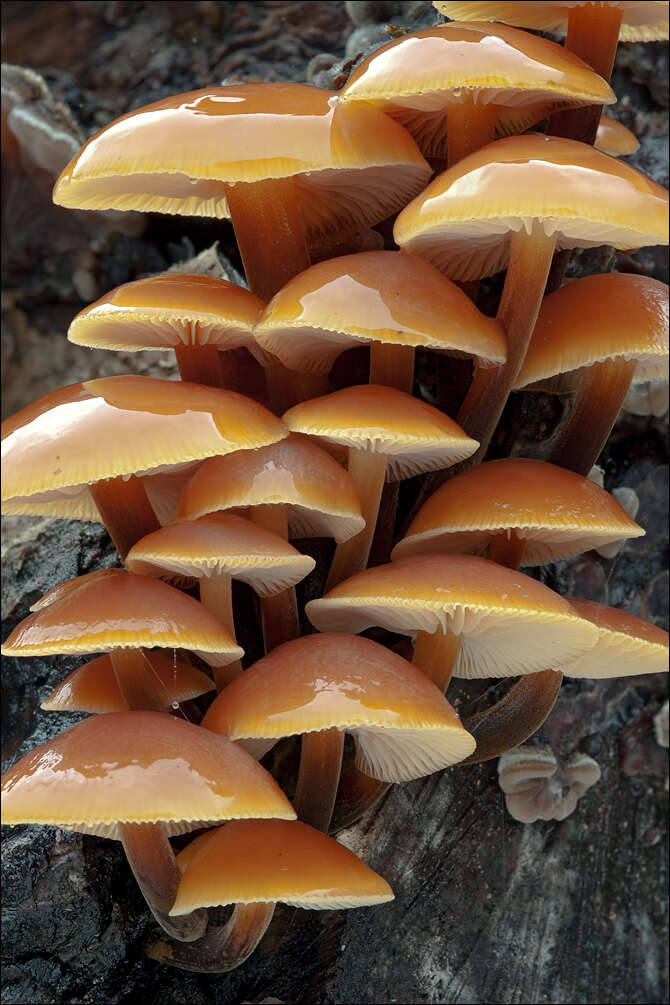
Flammulina velutipes (Curtis) SingerVelvet Shank, DE: Gemeiner Samtfussrbling, Gewonlicher SamtfssrublingSlo.: zimska panjevkaDat.: Nov. 28. 2014Lat.: 46.36066 Long.: 13.70907Code: Bot_851/2014_DSC4924Habitat: at the bottom of alpine valley, sawmill depot, next to the main road, flat terrain, full sun, humid place next to a river, exposed to direct rain, average precipitations ~ 3.000 mm/year, average temperature 7 - 9 deg C, elevation 550 m (1.800 feet), alpine phytogeographical region.Substratum: a big log of Juglans regia lying on ground in a pile of timber in a sawmill depot.Place: Lower Trenta valley, between villages Soa and Trenta, sawmill Otokar, Trenta 4, East Julian Alps, Posoje, Slovenia EC Comments: Flammulina velutipes is a striking fungus in several senses in spite of the fact that it is a widespread, common and easy to recognize. First, it is very beautiful mushroom displaying a vibrant contrast between its like fire orange, shiny and half translucent hut and deep black velvety stipe. Its rich colors exemplify an eye-catching contrast to often dull gray-brown mood of late autumn and winter nature in my country or to snow covered habitats. Its pilei withstand very low temperatures. Even completely frozen they recover and grow and sporulate after temperature again rises above freezing point. One can find them from October to March being most frequent in January (Ref.:2.). Another interesting thing is that they need short wavelength light (blue 470 nm and above) to develop pilei and to sporulate (Ref.:2.). I haven't found an explanation why they need it. Generally fungi do not need light since they have no chlorophyll to synthesize their own food.Flammulina velutipes grows as a saprobiont on wood of wide range of broadleaf trees, vast majority of them on Salix sp. and Fagus sylvatica. Fungi I found grew on Juglans regia, which is very seldom recorded. Only four of about thousand observations analyzed in Ref.:2. state Juglans regia as substratum. Taxonomy of this species is complex. Several taxa on f. and var. levels have been described. But, authors do not agree on them and Index Fungorum does not recognize them as valid names. The situation is well illustrated by the fact that there exist about 40 synonyms out of six genera. Also large differences in spore dimensions one can find in literature (see Fig. 2M) somehow confirm this.Pilei photographed grew in several clusters, more than 80 pilei altogether were present; pileus diameter 1.8 - 4.5 cm and height 1.2 - 1.8 cm, upper surface very slimy, stipe diameter 3 - 4 mm above and 3.5 - 7 mm at the base, hollow when mature, tough, fairly fibrous and often flattened or twisted; taste mild slightly on soap; smell very mild but distinct, on bleach?, SP abundant white, oac909.Spores dimensions: 7,0 [7,7 ; 8] 8,7 x 4,2 [4,6 ; 4,8] 5,2 microns; Q = 1,5 [1,6 ; 1,7] 1,8; N = 33; C = 95%; Me = 7,9 x 4,7 microns; Qe = 1,7. Olympus CH20, NEA 100x/1.25, magnification 1.000 x, oil, in water, Congo red. AmScope MA500 digital camera.Herbarium: Mycotheca and lichen herbarium (LJU-Li) of Slovenian Forestry Institute, Vena pot 2, Ljubljana, Index Herbariorum LJFRef.:(1) C. Bas, Flammulina in Western Europe, Persoonia (1983) 12 (1), pp 51-66 (cited in Ref.:2.) (2) G.J. Krieglsteiner (Hrsg.), Die Grosspilze Baden-Wrttembergs, Band 3., Ulmer (2001), p 245. (3) M. Bon, Parey's Buch der Pilze, Kosmos (2005), p 170.(4) R. M. Dhncke, 1200 Pilze in Farbfotos, AT Verlag (2009), p 389.(5) S. Buczacki, Collins Fungi Guide, Collins (2012), p 192. (6) R. Lueder, Grundkurs Pilzbestimmung, Quelle & Meyer (2008), p 388.(7)
trace.tennessee.edu/cgi/viewcontent.cgi?article=1006&...
-

Flammulina velutipes, probably Flammulina velutipes f. longispora Bas, Persoonia 12(1): 62 (1983)Winter Mushroom, Velvet StemSlo.: zimska panjevkaDat.: Dec. 11. 2011Lat.: 46.33440 Long.: 13.59756Code: Bot_581/2011_IMG8137 Habitat: Mainly broadleaf forest next to river bed, locally flat terrain but in a short gorge, calcareous bedrock, very humid place with several springs, mostly in shade, no sun during winter months, partly protected from direct rain by tree canopies, average precipitations ~ 3.000 mm/year, average temperature 8-10 deg C, elevation 410 m (1.350 feet), alpine phytogeographical region.Substratum: fallen thick Salix sp. trunk covered by mosses, partly rotten.Place: East Bovec basin, left shore of river Soa downstream of Krovec farm house, East Julian Alps, Posoje, Slovenia EC Comments: Spore print as well as habitat fit well to Flammulina velutipes f. longispora Bas, Persoonia 12(1): 62 (1983). This form is not (yet?) accepted by Index Fungorum however it is discribed in Ref (5). and Ref.(6). from where spore dimensions have been taken for this form. Growing in small groups and solitary, several fruitbodies; pileus diameter up to 6 cm (2.3 inch), sticky cap; SP white. Spore dimensions: 9.3 (SD = 0.6) x 3.5 (SD = 0.3) micr., Q = 2.7 (SD = 0.18), n = 30.Ref.:(1) D.Arora, Mushrooms Demystified, Ten Speed Press, Berkeley (1986), p 220. (2) M.Bon, Parey's Buch der Pilze, Kosmos (2005), p 170. (3) R.Lueder, Grundkurs Pilzbestimmung, Quelle & Meyer (2008), p 388. (4) A.Poler, Veselo po gobe (in Slovene), Mohorjeva druba Celovec (2002), p32. (5) R.M. Daehncke, 1200 Pilze in Farbfotos, AT Verlag (2009), p 389. (6) G.J.Krieglsteiner (Hrsg.), Die Grosspilze Bade-Wrttembergs, Band 3, Ulmer (2001), p245.
-
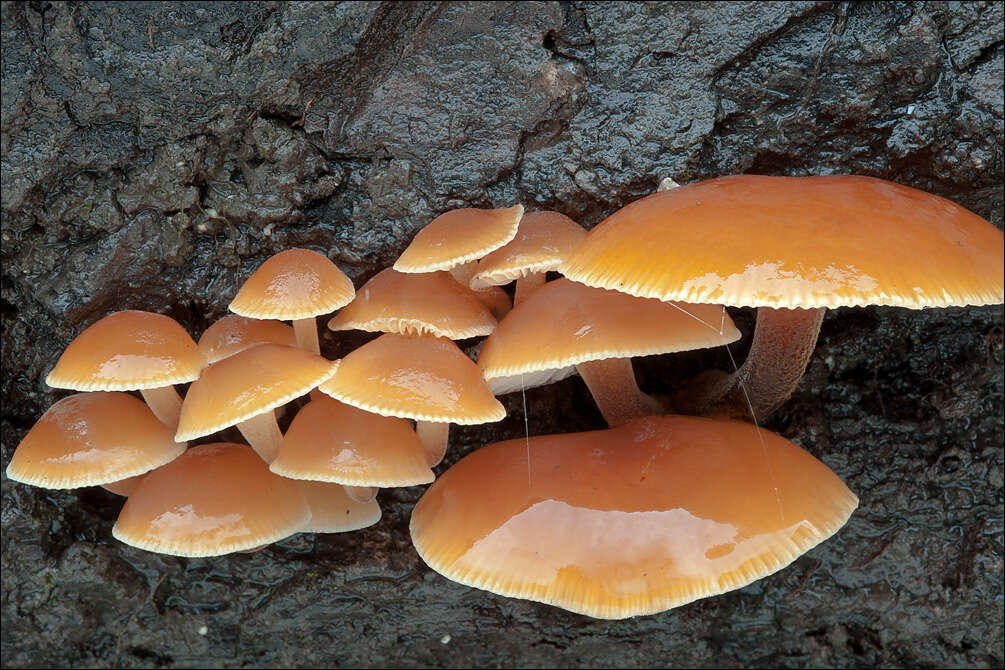
Flammulina velutipes (Curtis) SingerVelvet Shank, DE: Gemeiner Samtfussrbling, Gewonlicher SamtfssrublingSlo.: zimska panjevkaDat.: Nov. 28. 2014Lat.: 46.36066 Long.: 13.70907Code: Bot_851/2014_DSC4924Habitat: at the bottom of alpine valley, sawmill depot, next to the main road, flat terrain, full sun, humid place next to a river, exposed to direct rain, average precipitations ~ 3.000 mm/year, average temperature 7 - 9 deg C, elevation 550 m (1.800 feet), alpine phytogeographical region.Substratum: a big log of Juglans regia lying on ground in a pile of timber in a sawmill depot.Place: Lower Trenta valley, between villages Soa and Trenta, sawmill Otokar, Trenta 4, East Julian Alps, Posoje, Slovenia EC Comments: Flammulina velutipes is a striking fungus in several senses in spite of the fact that it is a widespread, common and easy to recognize. First, it is very beautiful mushroom displaying a vibrant contrast between its like fire orange, shiny and half translucent hut and deep black velvety stipe. Its rich colors exemplify an eye-catching contrast to often dull gray-brown mood of late autumn and winter nature in my country or to snow covered habitats. Its pilei withstand very low temperatures. Even completely frozen they recover and grow and sporulate after temperature again rises above freezing point. One can find them from October to March being most frequent in January (Ref.:2.). Another interesting thing is that they need short wavelength light (blue 470 nm and above) to develop pilei and to sporulate (Ref.:2.). I haven't found an explanation why they need it. Generally fungi do not need light since they have no chlorophyll to synthesize their own food.Flammulina velutipes grows as a saprobiont on wood of wide range of broadleaf trees, vast majority of them on Salix sp. and Fagus sylvatica. Fungi I found grew on Juglans regia, which is very seldom recorded. Only four of about thousand observations analyzed in Ref.:2. state Juglans regia as substratum. Taxonomy of this species is complex. Several taxa on f. and var. levels have been described. But, authors do not agree on them and Index Fungorum does not recognize them as valid names. The situation is well illustrated by the fact that there exist about 40 synonyms out of six genera. Also large differences in spore dimensions one can find in literature (see Fig. 2M) somehow confirm this.Pilei photographed grew in several clusters, more than 80 pilei altogether were present; pileus diameter 1.8 - 4.5 cm and height 1.2 - 1.8 cm, upper surface very slimy, stipe diameter 3 - 4 mm above and 3.5 - 7 mm at the base, hollow when mature, tough, fairly fibrous and often flattened or twisted; taste mild slightly on soap; smell very mild but distinct, on bleach?, SP abundant white, oac909.Spores dimensions: 7,0 [7,7 ; 8] 8,7 x 4,2 [4,6 ; 4,8] 5,2 microns; Q = 1,5 [1,6 ; 1,7] 1,8; N = 33; C = 95%; Me = 7,9 x 4,7 microns; Qe = 1,7. Olympus CH20, NEA 100x/1.25, magnification 1.000 x, oil, in water, Congo red. AmScope MA500 digital camera.Herbarium: Mycotheca and lichen herbarium (LJU-Li) of Slovenian Forestry Institute, Vena pot 2, Ljubljana, Index Herbariorum LJFRef.:(1) C. Bas, Flammulina in Western Europe, Persoonia (1983) 12 (1), pp 51-66 (cited in Ref.:2.) (2) G.J. Krieglsteiner (Hrsg.), Die Grosspilze Baden-Wrttembergs, Band 3., Ulmer (2001), p 245. (3) M. Bon, Parey's Buch der Pilze, Kosmos (2005), p 170.(4) R. M. Dhncke, 1200 Pilze in Farbfotos, AT Verlag (2009), p 389.(5) S. Buczacki, Collins Fungi Guide, Collins (2012), p 192. (6) R. Lueder, Grundkurs Pilzbestimmung, Quelle & Meyer (2008), p 388.(7)
trace.tennessee.edu/cgi/viewcontent.cgi?article=1006&...
-
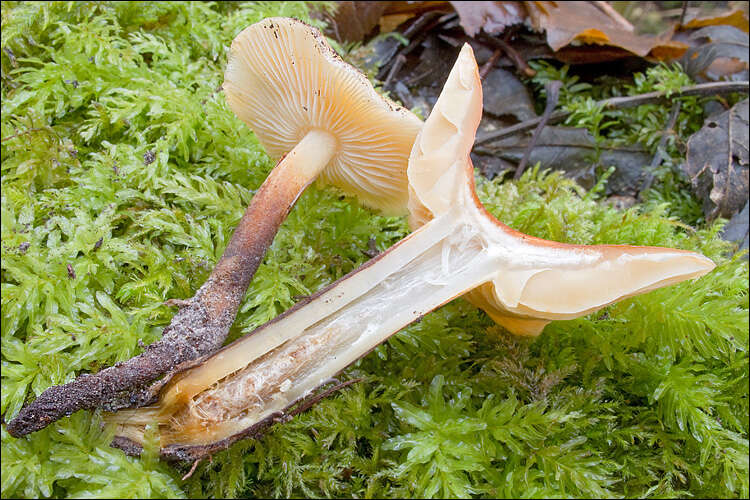
Flammulina velutipes, probably Flammulina velutipes f. longispora Bas, Persoonia 12(1): 62 (1983)Winter Mushroom, Velvet StemSlo.: zimska panjevkaDat.: Dec. 11. 2011Lat.: 46.33440 Long.: 13.59756Code: Bot_581/2011_IMG8137 Habitat: Mainly broadleaf forest next to river bed, locally flat terrain but in a short gorge, calcareous bedrock, very humid place with several springs, mostly in shade, no sun during winter months, partly protected from direct rain by tree canopies, average precipitations ~ 3.000 mm/year, average temperature 8-10 deg C, elevation 410 m (1.350 feet), alpine phytogeographical region.Substratum: fallen thick Salix sp. trunk covered by mosses, partly rotten.Place: East Bovec basin, left shore of river Soa downstream of Krovec farm house, East Julian Alps, Posoje, Slovenia EC Comments: Spore print as well as habitat fit well to Flammulina velutipes f. longispora Bas, Persoonia 12(1): 62 (1983). This form is not (yet?) accepted by Index Fungorum however it is discribed in Ref (5). and Ref.(6). from where spore dimensions have been taken for this form. Growing in small groups and solitary, several fruitbodies; pileus diameter up to 6 cm (2.3 inch), sticky cap; SP white. Spore dimensions: 9.3 (SD = 0.6) x 3.5 (SD = 0.3) micr., Q = 2.7 (SD = 0.18), n = 30.Ref.:(1) D.Arora, Mushrooms Demystified, Ten Speed Press, Berkeley (1986), p 220. (2) M.Bon, Parey's Buch der Pilze, Kosmos (2005), p 170. (3) R.Lueder, Grundkurs Pilzbestimmung, Quelle & Meyer (2008), p 388. (4) A.Poler, Veselo po gobe (in Slovene), Mohorjeva druba Celovec (2002), p32. (5) R.M. Daehncke, 1200 Pilze in Farbfotos, AT Verlag (2009), p 389. (6) G.J.Krieglsteiner (Hrsg.), Die Grosspilze Bade-Wrttembergs, Band 3, Ulmer (2001), p245.
-
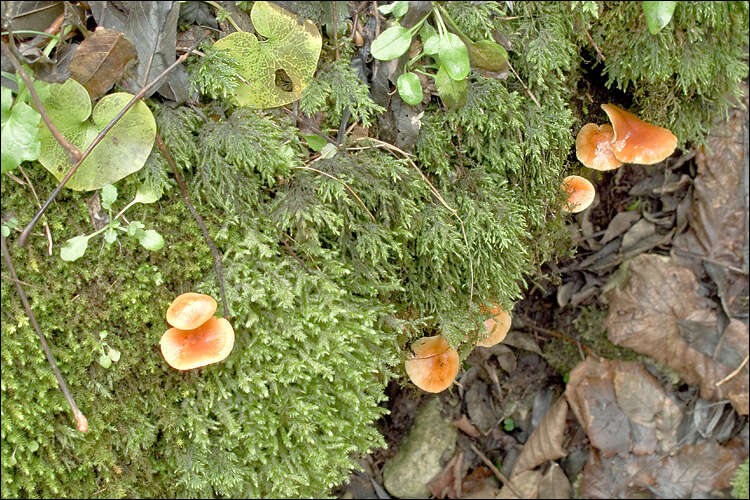
Flammulina velutipes, probably Flammulina velutipes f. longispora Bas, Persoonia 12(1): 62 (1983)Winter Mushroom, Velvet StemSlo.: zimska panjevkaDat.: Dec. 11. 2011Lat.: 46.33440 Long.: 13.59756Code: Bot_581/2011_IMG8137 Habitat: Mainly broadleaf forest next to river bed, locally flat terrain but in a short gorge, calcareous bedrock, very humid place with several springs, mostly in shade, no sun during winter months, partly protected from direct rain by tree canopies, average precipitations ~ 3.000 mm/year, average temperature 8-10 deg C, elevation 410 m (1.350 feet), alpine phytogeographical region.Substratum: fallen thick Salix sp. trunk covered by mosses, partly rotten.Place: East Bovec basin, left shore of river Soa downstream of Krovec farm house, East Julian Alps, Posoje, Slovenia EC Comments: Spore print as well as habitat fit well to Flammulina velutipes f. longispora Bas, Persoonia 12(1): 62 (1983). This form is not (yet?) accepted by Index Fungorum however it is discribed in Ref (5). and Ref.(6). from where spore dimensions have been taken for this form. Growing in small groups and solitary, several fruitbodies; pileus diameter up to 6 cm (2.3 inch), sticky cap; SP white. Spore dimensions: 9.3 (SD = 0.6) x 3.5 (SD = 0.3) micr., Q = 2.7 (SD = 0.18), n = 30.Ref.:(1) D.Arora, Mushrooms Demystified, Ten Speed Press, Berkeley (1986), p 220. (2) M.Bon, Parey's Buch der Pilze, Kosmos (2005), p 170. (3) R.Lueder, Grundkurs Pilzbestimmung, Quelle & Meyer (2008), p 388. (4) A.Poler, Veselo po gobe (in Slovene), Mohorjeva druba Celovec (2002), p32. (5) R.M. Daehncke, 1200 Pilze in Farbfotos, AT Verlag (2009), p 389. (6) G.J.Krieglsteiner (Hrsg.), Die Grosspilze Bade-Wrttembergs, Band 3, Ulmer (2001), p245.
-
Photographed in Mt Field National Park, along the Russell and Horseshoe Falls track.Ok, I think this could be Flammulina velutipes... or maybe Collybia eucalyptorum? I'm not sure which. The caps were very smooth and shiny and only had a small umbo. The stipes were very dark and velvety-looking. I've only just noticed the smaller fungi in amongst them... Oh well, something else to try to identify!
IDENTIFYING AUSTRALIAN RAINFOREST PLANTS,TREES & FUNGI - Flick Group -->
DATABASE INDEX -
TAGS
-

Flammulina velutipes, probably Flammulina velutipes f. longispora Bas, Persoonia 12(1): 62 (1983)Winter Mushroom, Velvet StemSlo.: zimska panjevkaDat.: Dec. 11. 2011Lat.: 46.33440 Long.: 13.59756Code: Bot_581/2011_IMG8137 Habitat: Mainly broadleaf forest next to river bed, locally flat terrain but in a short gorge, calcareous bedrock, very humid place with several springs, mostly in shade, no sun during winter months, partly protected from direct rain by tree canopies, average precipitations ~ 3.000 mm/year, average temperature 8-10 deg C, elevation 410 m (1.350 feet), alpine phytogeographical region.Substratum: fallen thick Salix sp. trunk covered by mosses, partly rotten.Place: East Bovec basin, left shore of river Soa downstream of Krovec farm house, East Julian Alps, Posoje, Slovenia EC Comments: Spore print as well as habitat fit well to Flammulina velutipes f. longispora Bas, Persoonia 12(1): 62 (1983). This form is not (yet?) accepted by Index Fungorum however it is discribed in Ref (5). and Ref.(6). from where spore dimensions have been taken for this form. Growing in small groups and solitary, several fruitbodies; pileus diameter up to 6 cm (2.3 inch), sticky cap; SP white. Spore dimensions: 9.3 (SD = 0.6) x 3.5 (SD = 0.3) micr., Q = 2.7 (SD = 0.18), n = 30. Motic B2-211A, magnification 1.000 x, oil, in water. Congo Red. Ref.:(1) D.Arora, Mushrooms Demystified, Ten Speed Press, Berkeley (1986), p 220. (2) M.Bon, Parey's Buch der Pilze, Kosmos (2005), p 170. (3) R.Lueder, Grundkurs Pilzbestimmung, Quelle & Meyer (2008), p 388. (4) A.Poler, Veselo po gobe (in Slovene), Mohorjeva druba Celovec (2002), p32. (5) R.M. Daehncke, 1200 Pilze in Farbfotos, AT Verlag (2009), p 389. (6) G.J.Krieglsteiner (Hrsg.), Die Grosspilze Bade-Wrttembergs, Band 3, Ulmer (2001), p245.
-
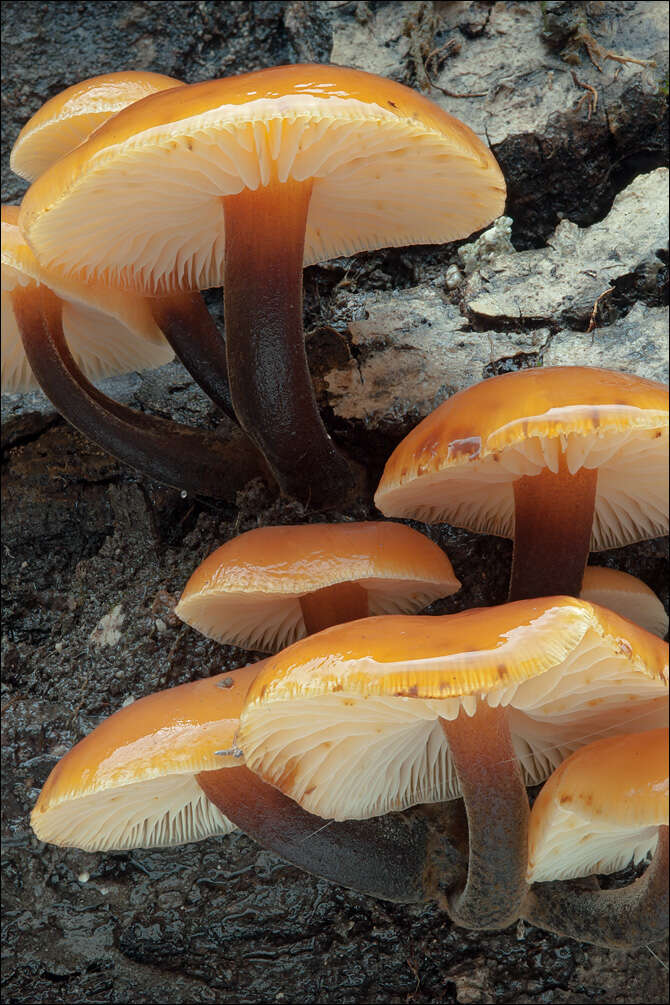
Flammulina velutipes (Curtis) SingerVelvet Shank, DE: Gemeiner Samtfussrbling, Gewonlicher SamtfssrublingSlo.: zimska panjevkaDat.: Nov. 28. 2014Lat.: 46.36066 Long.: 13.70907Code: Bot_851/2014_DSC4924Habitat: at the bottom of alpine valley, sawmill depot, next to the main road, flat terrain, full sun, humid place next to a river, exposed to direct rain, average precipitations ~ 3.000 mm/year, average temperature 7 - 9 deg C, elevation 550 m (1.800 feet), alpine phytogeographical region.Substratum: a big log of Juglans regia lying on ground in a pile of timber in a sawmill depot.Place: Lower Trenta valley, between villages Soa and Trenta, sawmill Otokar, Trenta 4, East Julian Alps, Posoje, Slovenia EC Comments: Flammulina velutipes is a striking fungus in several senses in spite of the fact that it is a widespread, common and easy to recognize. First, it is very beautiful mushroom displaying a vibrant contrast between its like fire orange, shiny and half translucent hut and deep black velvety stipe. Its rich colors exemplify an eye-catching contrast to often dull gray-brown mood of late autumn and winter nature in my country or to snow covered habitats. Its pilei withstand very low temperatures. Even completely frozen they recover and grow and sporulate after temperature again rises above freezing point. One can find them from October to March being most frequent in January (Ref.:2.). Another interesting thing is that they need short wavelength light (blue 470 nm and above) to develop pilei and to sporulate (Ref.:2.). I haven't found an explanation why they need it. Generally fungi do not need light since they have no chlorophyll to synthesize their own food.Flammulina velutipes grows as a saprobiont on wood of wide range of broadleaf trees, vast majority of them on Salix sp. and Fagus sylvatica. Fungi I found grew on Juglans regia, which is very seldom recorded. Only four of about thousand observations analyzed in Ref.:2. state Juglans regia as substratum. Taxonomy of this species is complex. Several taxa on f. and var. levels have been described. But, authors do not agree on them and Index Fungorum does not recognize them as valid names. The situation is well illustrated by the fact that there exist about 40 synonyms out of six genera. Also large differences in spore dimensions one can find in literature (see Fig. 2M) somehow confirm this.Pilei photographed grew in several clusters, more than 80 pilei altogether were present; pileus diameter 1.8 - 4.5 cm and height 1.2 - 1.8 cm, upper surface very slimy, stipe diameter 3 - 4 mm above and 3.5 - 7 mm at the base, hollow when mature, tough, fairly fibrous and often flattened or twisted; taste mild slightly on soap; smell very mild but distinct, on bleach?, SP abundant white, oac909.Spores dimensions: 7,0 [7,7 ; 8] 8,7 x 4,2 [4,6 ; 4,8] 5,2 microns; Q = 1,5 [1,6 ; 1,7] 1,8; N = 33; C = 95%; Me = 7,9 x 4,7 microns; Qe = 1,7. Olympus CH20, NEA 100x/1.25, magnification 1.000 x, oil, in water, Congo red. AmScope MA500 digital camera.Herbarium: Mycotheca and lichen herbarium (LJU-Li) of Slovenian Forestry Institute, Vena pot 2, Ljubljana, Index Herbariorum LJFRef.:(1) C. Bas, Flammulina in Western Europe, Persoonia (1983) 12 (1), pp 51-66 (cited in Ref.:2.) (2) G.J. Krieglsteiner (Hrsg.), Die Grosspilze Baden-Wrttembergs, Band 3., Ulmer (2001), p 245. (3) M. Bon, Parey's Buch der Pilze, Kosmos (2005), p 170.(4) R. M. Dhncke, 1200 Pilze in Farbfotos, AT Verlag (2009), p 389.(5) S. Buczacki, Collins Fungi Guide, Collins (2012), p 192. (6) R. Lueder, Grundkurs Pilzbestimmung, Quelle & Meyer (2008), p 388.(7)
trace.tennessee.edu/cgi/viewcontent.cgi?article=1006&...
-
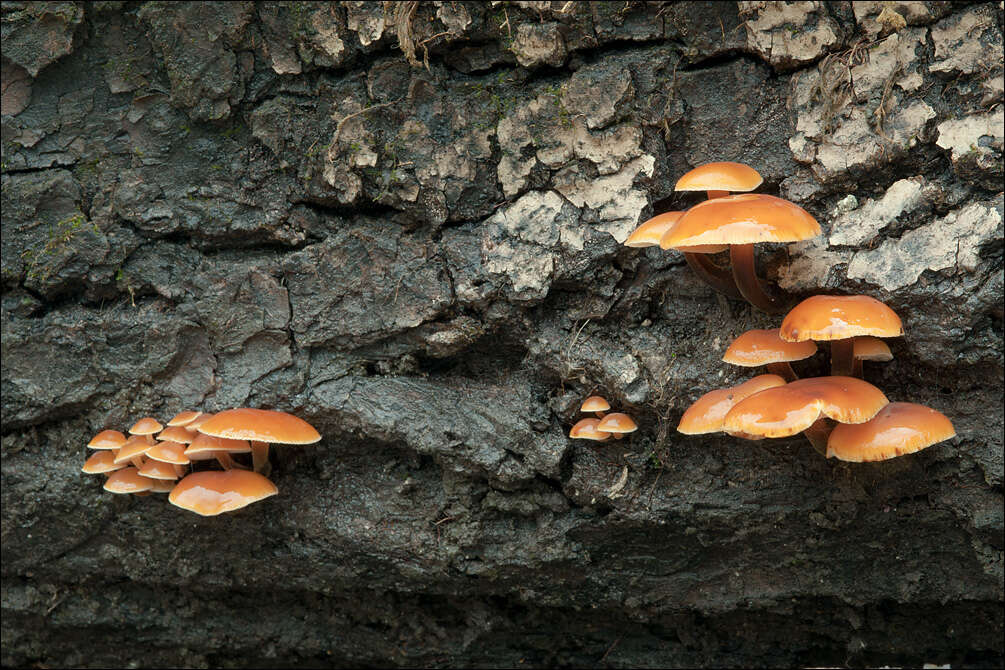
Flammulina velutipes (Curtis) SingerVelvet Shank, DE: Gemeiner Samtfussrbling, Gewonlicher SamtfssrublingSlo.: zimska panjevkaDat.: Nov. 28. 2014Lat.: 46.36066 Long.: 13.70907Code: Bot_851/2014_DSC4924Habitat: at the bottom of alpine valley, sawmill depot, next to the main road, flat terrain, full sun, humid place next to a river, exposed to direct rain, average precipitations ~ 3.000 mm/year, average temperature 7 - 9 deg C, elevation 550 m (1.800 feet), alpine phytogeographical region.Substratum: a big log of Juglans regia lying on ground in a pile of timber in a sawmill depot.Place: Lower Trenta valley, between villages Soa and Trenta, sawmill Otokar, Trenta 4, East Julian Alps, Posoje, Slovenia EC Comments: Flammulina velutipes is a striking fungus in several senses in spite of the fact that it is a widespread, common and easy to recognize. First, it is very beautiful mushroom displaying a vibrant contrast between its like fire orange, shiny and half translucent hut and deep black velvety stipe. Its rich colors exemplify an eye-catching contrast to often dull gray-brown mood of late autumn and winter nature in my country or to snow covered habitats. Its pilei withstand very low temperatures. Even completely frozen they recover and grow and sporulate after temperature again rises above freezing point. One can find them from October to March being most frequent in January (Ref.:2.). Another interesting thing is that they need short wavelength light (blue 470 nm and above) to develop pilei and to sporulate (Ref.:2.). I haven't found an explanation why they need it. Generally fungi do not need light since they have no chlorophyll to synthesize their own food.Flammulina velutipes grows as a saprobiont on wood of wide range of broadleaf trees, vast majority of them on Salix sp. and Fagus sylvatica. Fungi I found grew on Juglans regia, which is very seldom recorded. Only four of about thousand observations analyzed in Ref.:2. state Juglans regia as substratum. Taxonomy of this species is complex. Several taxa on f. and var. levels have been described. But, authors do not agree on them and Index Fungorum does not recognize them as valid names. The situation is well illustrated by the fact that there exist about 40 synonyms out of six genera. Also large differences in spore dimensions one can find in literature (see Fig. 2M) somehow confirm this.Pilei photographed grew in several clusters, more than 80 pilei altogether were present; pileus diameter 1.8 - 4.5 cm and height 1.2 - 1.8 cm, upper surface very slimy, stipe diameter 3 - 4 mm above and 3.5 - 7 mm at the base, hollow when mature, tough, fairly fibrous and often flattened or twisted; taste mild slightly on soap; smell very mild but distinct, on bleach?, SP abundant white, oac909.Spores dimensions: 7,0 [7,7 ; 8] 8,7 x 4,2 [4,6 ; 4,8] 5,2 microns; Q = 1,5 [1,6 ; 1,7] 1,8; N = 33; C = 95%; Me = 7,9 x 4,7 microns; Qe = 1,7. Olympus CH20, NEA 100x/1.25, magnification 1.000 x, oil, in water, Congo red. AmScope MA500 digital camera.Herbarium: Mycotheca and lichen herbarium (LJU-Li) of Slovenian Forestry Institute, Vena pot 2, Ljubljana, Index Herbariorum LJFRef.:(1) C. Bas, Flammulina in Western Europe, Persoonia (1983) 12 (1), pp 51-66 (cited in Ref.:2.) (2) G.J. Krieglsteiner (Hrsg.), Die Grosspilze Baden-Wrttembergs, Band 3., Ulmer (2001), p 245. (3) M. Bon, Parey's Buch der Pilze, Kosmos (2005), p 170.(4) R. M. Dhncke, 1200 Pilze in Farbfotos, AT Verlag (2009), p 389.(5) S. Buczacki, Collins Fungi Guide, Collins (2012), p 192. (6) R. Lueder, Grundkurs Pilzbestimmung, Quelle & Meyer (2008), p 388.(7)
trace.tennessee.edu/cgi/viewcontent.cgi?article=1006&...
-
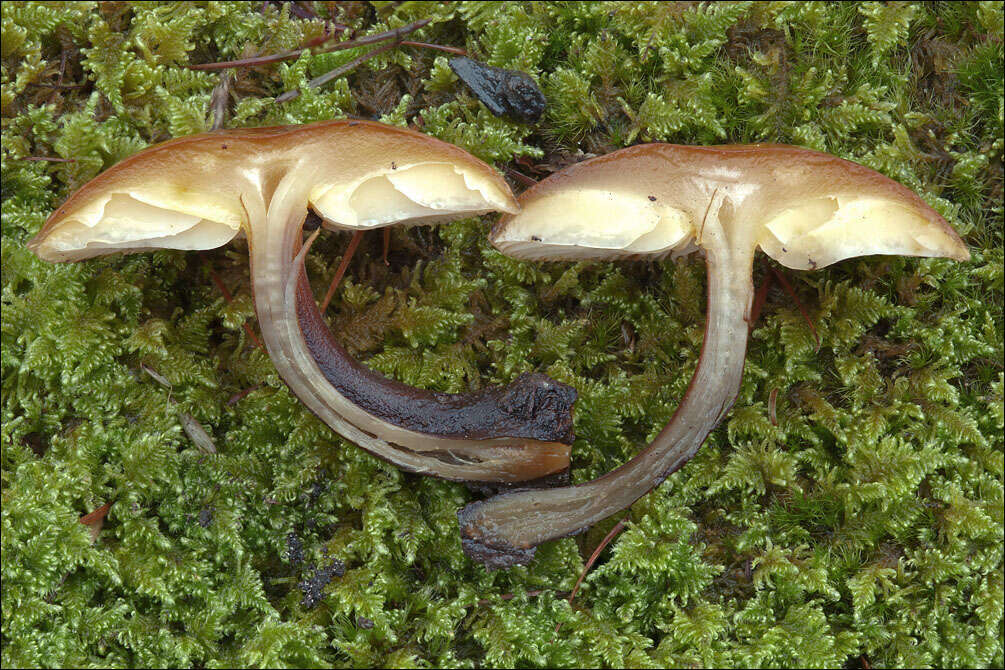
Flammulina velutipes (Curtis) SingerVelvet Shank, DE: Gemeiner Samtfussrbling, Gewonlicher SamtfssrublingSlo.: zimska panjevkaDat.: Nov. 28. 2014Lat.: 46.36066 Long.: 13.70907Code: Bot_851/2014_DSC4924Habitat: at the bottom of alpine valley, sawmill depot, next to the main road, flat terrain, full sun, humid place next to a river, exposed to direct rain, average precipitations ~ 3.000 mm/year, average temperature 7 - 9 deg C, elevation 550 m (1.800 feet), alpine phytogeographical region.Substratum: a big log of Juglans regia lying on ground in a pile of timber in a sawmill depot.Place: Lower Trenta valley, between villages Soa and Trenta, sawmill Otokar, Trenta 4, East Julian Alps, Posoje, Slovenia EC Comments: Flammulina velutipes is a striking fungus in several senses in spite of the fact that it is a widespread, common and easy to recognize. First, it is very beautiful mushroom displaying a vibrant contrast between its like fire orange, shiny and half translucent hut and deep black velvety stipe. Its rich colors exemplify an eye-catching contrast to often dull gray-brown mood of late autumn and winter nature in my country or to snow covered habitats. Its pilei withstand very low temperatures. Even completely frozen they recover and grow and sporulate after temperature again rises above freezing point. One can find them from October to March being most frequent in January (Ref.:2.). Another interesting thing is that they need short wavelength light (blue 470 nm and above) to develop pilei and to sporulate (Ref.:2.). I haven't found an explanation why they need it. Generally fungi do not need light since they have no chlorophyll to synthesize their own food.Flammulina velutipes grows as a saprobiont on wood of wide range of broadleaf trees, vast majority of them on Salix sp. and Fagus sylvatica. Fungi I found grew on Juglans regia, which is very seldom recorded. Only four of about thousand observations analyzed in Ref.:2. state Juglans regia as substratum. Taxonomy of this species is complex. Several taxa on f. and var. levels have been described. But, authors do not agree on them and Index Fungorum does not recognize them as valid names. The situation is well illustrated by the fact that there exist about 40 synonyms out of six genera. Also large differences in spore dimensions one can find in literature (see Fig. 2M) somehow confirm this.Pilei photographed grew in several clusters, more than 80 pilei altogether were present; pileus diameter 1.8 - 4.5 cm and height 1.2 - 1.8 cm, upper surface very slimy, stipe diameter 3 - 4 mm above and 3.5 - 7 mm at the base, hollow when mature, tough, fairly fibrous and often flattened or twisted; taste mild slightly on soap; smell very mild but distinct, on bleach?, SP abundant white, oac909.Spores dimensions: 7,0 [7,7 ; 8] 8,7 x 4,2 [4,6 ; 4,8] 5,2 microns; Q = 1,5 [1,6 ; 1,7] 1,8; N = 33; C = 95%; Me = 7,9 x 4,7 microns; Qe = 1,7. Olympus CH20, NEA 100x/1.25, magnification 1.000 x, oil, in water, Congo red. AmScope MA500 digital camera.Herbarium: Mycotheca and lichen herbarium (LJU-Li) of Slovenian Forestry Institute, Vena pot 2, Ljubljana, Index Herbariorum LJFRef.:(1) C. Bas, Flammulina in Western Europe, Persoonia (1983) 12 (1), pp 51-66 (cited in Ref.:2.) (2) G.J. Krieglsteiner (Hrsg.), Die Grosspilze Baden-Wrttembergs, Band 3., Ulmer (2001), p 245. (3) M. Bon, Parey's Buch der Pilze, Kosmos (2005), p 170.(4) R. M. Dhncke, 1200 Pilze in Farbfotos, AT Verlag (2009), p 389.(5) S. Buczacki, Collins Fungi Guide, Collins (2012), p 192. (6) R. Lueder, Grundkurs Pilzbestimmung, Quelle & Meyer (2008), p 388.(7)
trace.tennessee.edu/cgi/viewcontent.cgi?article=1006&...
-
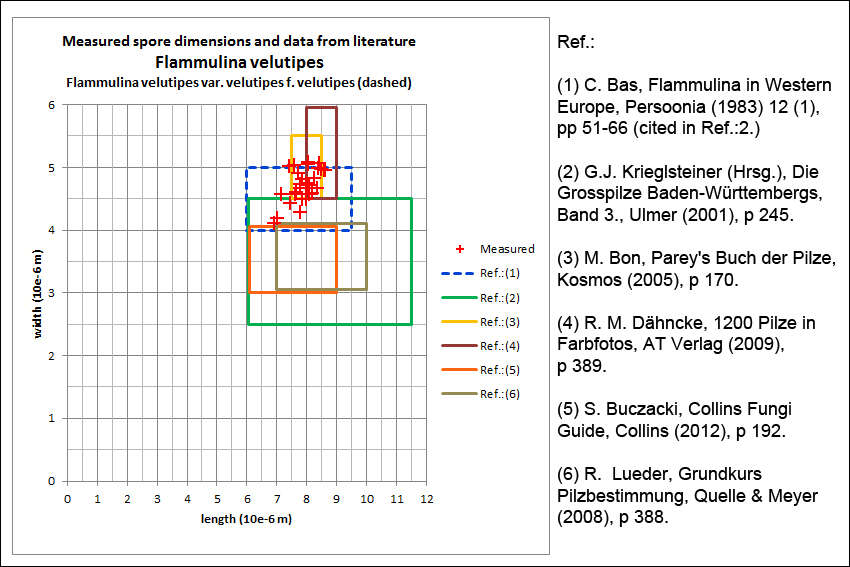
Flammulina velutipes (Curtis) SingerVelvet Shank, DE: Gemeiner Samtfussrbling, Gewonlicher SamtfssrublingSlo.: zimska panjevkaDat.: Nov. 28. 2014Lat.: 46.36066 Long.: 13.70907Code: Bot_851/2014_DSC4924Habitat: at the bottom of alpine valley, sawmill depot, next to the main road, flat terrain, full sun, humid place next to a river, exposed to direct rain, average precipitations ~ 3.000 mm/year, average temperature 7 - 9 deg C, elevation 550 m (1.800 feet), alpine phytogeographical region.Substratum: a big log of Juglans regia lying on ground in a pile of timber in a sawmill depot.Place: Lower Trenta valley, between villages Soa and Trenta, sawmill Otokar, Trenta 4, East Julian Alps, Posoje, Slovenia EC Comments: Flammulina velutipes is a striking fungus in several senses in spite of the fact that it is a widespread, common and easy to recognize. First, it is very beautiful mushroom displaying a vibrant contrast between its like fire orange, shiny and half translucent hut and deep black velvety stipe. Its rich colors exemplify an eye-catching contrast to often dull gray-brown mood of late autumn and winter nature in my country or to snow covered habitats. Its pilei withstand very low temperatures. Even completely frozen they recover and grow and sporulate after temperature again rises above freezing point. One can find them from October to March being most frequent in January (Ref.:2.). Another interesting thing is that they need short wavelength light (blue 470 nm and above) to develop pilei and to sporulate (Ref.:2.). I haven't found an explanation why they need it. Generally fungi do not need light since they have no chlorophyll to synthesize their own food.Flammulina velutipes grows as a saprobiont on wood of wide range of broadleaf trees, vast majority of them on Salix sp. and Fagus sylvatica. Fungi I found grew on Juglans regia, which is very seldom recorded. Only four of about thousand observations analyzed in Ref.:2. state Juglans regia as substratum. Taxonomy of this species is complex. Several taxa on f. and var. levels have been described. But, authors do not agree on them and Index Fungorum does not recognize them as valid names. The situation is well illustrated by the fact that there exist about 40 synonyms out of six genera. Also large differences in spore dimensions one can find in literature (see Fig. 2M) somehow confirm this.Pilei photographed grew in several clusters, more than 80 pilei altogether were present; pileus diameter 1.8 - 4.5 cm and height 1.2 - 1.8 cm, upper surface very slimy, stipe diameter 3 - 4 mm above and 3.5 - 7 mm at the base, hollow when mature, tough, fairly fibrous and often flattened or twisted; taste mild slightly on soap; smell very mild but distinct, on bleach?, SP abundant white, oac909.Spores dimensions: 7,0 [7,7 ; 8] 8,7 x 4,2 [4,6 ; 4,8] 5,2 microns; Q = 1,5 [1,6 ; 1,7] 1,8; N = 33; C = 95%; Me = 7,9 x 4,7 microns; Qe = 1,7. Olympus CH20, NEA 100x/1.25, magnification 1.000 x, oil, in water, Congo red. AmScope MA500 digital camera.Herbarium: Mycotheca and lichen herbarium (LJU-Li) of Slovenian Forestry Institute, Vena pot 2, Ljubljana, Index Herbariorum LJFRef.:(1) C. Bas, Flammulina in Western Europe, Persoonia (1983) 12 (1), pp 51-66 (cited in Ref.:2.) (2) G.J. Krieglsteiner (Hrsg.), Die Grosspilze Baden-Wrttembergs, Band 3., Ulmer (2001), p 245. (3) M. Bon, Parey's Buch der Pilze, Kosmos (2005), p 170.(4) R. M. Dhncke, 1200 Pilze in Farbfotos, AT Verlag (2009), p 389.(5) S. Buczacki, Collins Fungi Guide, Collins (2012), p 192. (6) R. Lueder, Grundkurs Pilzbestimmung, Quelle & Meyer (2008), p 388.(7)
trace.tennessee.edu/cgi/viewcontent.cgi?article=1006&...








